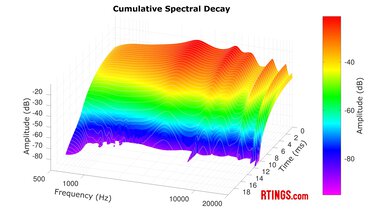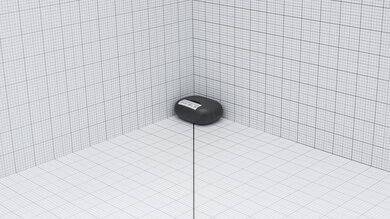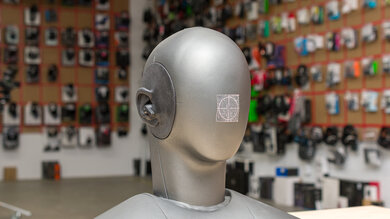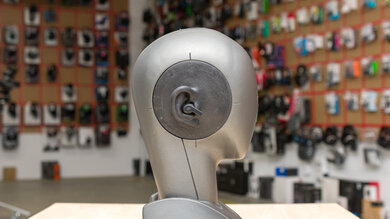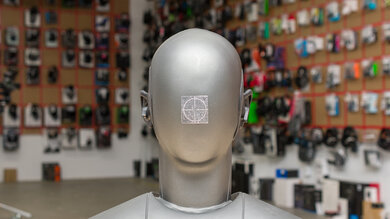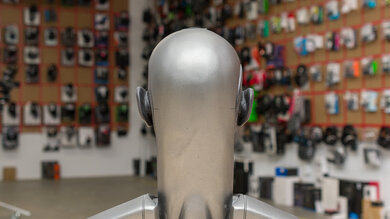The JBL Vibe Beam True Wireless (also known as the JBL Wave Beam in some markets) are simple in-ears designed for on-the-go use. They're budget-friendly buds that offer a few extra features compared to similarly priced models, especially since they give you access to a parametric EQ and presets for sound customization in the JBL Headphones app. Use their Ambient Aware mode when you want to stay aware of your surroundings, or activate TalkThru mode if you want to hold a conversation without removing your earbuds. However, these headphones lack some more premium features, such as a dedicated ANC feature.
Our Verdict
The JBL Vibe Beam are decent for sports and fitness. These small and lightweight in-ears are easy to bring to the gym, and their portable charging case helps protect them along the way. They're even rated IP56 for dust and water resistance, so you can use them for outdoor workouts in the park. That said, their unique shape isn't ideal for all ears, and they can fall out from more intense movements, so you'll want to be careful with them.
- IP56 rating for dust and water resistance.
- Small and lightweight design.
- Easy-to-use controls.
- Very good microphone recording quality.
- Can move around from more intense head movements.
- Not comfortable for all ears.
- No ANC.
- No multi-device pairing.
The JBL Vibe Beam are okay for commuting and travel. Their small, lightweight design makes them easy to bring along with you, especially since they fit most pockets. They last around eight hours on one charge, and you can always recharge them on the go using their case. Various settings like Ambient Aware and TalkThru give you some control over how much noise you hear from your surroundings, too. However, without a dedicated ANC feature, these headphones can't block out more bass-heavy sounds like bus and plane engines.
- IP56 rating for dust and water resistance.
- Small and lightweight design.
- Easy-to-use controls.
- Very good microphone recording quality.
- Can move around from more intense head movements.
- Not comfortable for all ears.
- No ANC.
- No multi-device pairing.
The JBL Vibe Beam are fair for office use. These headphones have a roughly eight-hour battery life that will get you through most work days, especially since they come with a case for easy on-the-go charging. They lack ANC, but they still passively block out most office chatter. Plus, you can control how much sound you hear through the headphones, with an Ambient Aware mode to let in some background noise, as well as a TalkThru mode to hear what your coworkers are saying without removing your buds.
- Easy-to-use controls.
- Very good microphone recording quality.
- Not comfortable for all ears.
- No ANC.
The JBL Vibe Beam aren't designed for wireless gaming. You can connect them to your PC over Bluetooth, but their latency is very high in their default Audio mode. You'll want to switch to their Video mode in their companion app, which reduces latency. However, you'll still encounter lip-sync issues, which can make or break your gaming experience.
You can't use the JBL Vibe Beam with a wired connection.
The JBL Vibe Beam have decent audio reproduction accuracy. On the plus side, they don't deviate much from their balanced sound, which suits all kinds of audio. Bass drums feel suitably thick and punchy, and vocals sound present and detailed. Unfortunately, they're let down by mediocre matching of the left and right drivers, so centrally panned elements like bass guitars can feel slightly lopsided.
The JBL Vibe Beam earbuds don't have an active noise cancelling (ANC) system. As a result, they can only block out noise passively, via the seal they create with your ears. That said, they do an acceptable job on that front and are decent at blocking out mid-range noises like chatty coworkers. But they do a worse job blocking out bass-range noise like the rumble of passing trains. On the plus side, they leak almost no audio.
The JBL Vibe Beam's mic is satisfactory. It has a very good recording quality that clearly reproduces your voice. That said, the mic does a worse job at separating your voice from any noise around you, so these aren't the best if you need to take calls in busy environments.
The JBL Vibe Beam earbuds have excellent frequency response consistency. With a good fit, you'll experience consistent audio delivery with every wear.
Performance Usages
Changelog
-
Updated Nov 25, 2025:
This review has been updated to Test Bench 2.0, which adds the following tests: Stereo Mismatch, Group Delay, Cumulative Spectral Decay, PRTF, Harmonic Distortion, and Electrical Aspects. We've added new performance usages and updated the text throughout the Sound tests and side-by-sides.
- Updated Nov 18, 2025: We've converted this review to Test Bench 2.0, which updates our sound tests and adds performance usages. You can read more about this in our changelog.
-
Updated Dec 05, 2024:
Several Sound tests have been updated following Test Bench 1.8. There have also been text changes made throughout the review, including to the usages and product comparisons to match these results.
- Updated Dec 02, 2024: We've converted this review to Test Bench 1.8, which updates our target curve and Sound tests. You can read more about this in our changelog.
Check Price
Differences Between Sizes And Variants
The JBL Vibe Beam are available in several different color variants: 'Beige,' 'Mint,' 'White,' 'Blue,' and 'Black.' We tested the Black variant, and you can see the label here. We expect the other variants to perform similarly. In some markets outside North America, these headphones are known as the JBL Wave Beam.
If you come across another version of these headphones, let us know in the comments, and we'll update our review.
Popular Headphones Comparisons
The JBL Vibe Beam join the JBL Vibe 100TWS True Wireless as a part of the manufacturer's more budget-friendly in-ear lineup. They're fairly simple headphones that lack some more premium features like ANC. However, they come with app support, a longer battery life, and ambient noise control features similar to those of the JBL Live Pro 2 TWS True Wireless.
See also our recommendations for the best wireless earbuds, the best budget wireless earbuds, and the best wireless earbuds for running.
The JBL Vibe Beam True Wireless and the JBL Vibe Buds True Wireless are similarly performing buds with different looks, so depending on your preferences, you may prefer either one. While both buds have a similar battery life and companion app support, the Vibe Beam have an ear stem design, and their carrying case has a lid. Conversely, the Vibe Buds have a pure earbud design, which is more comfortable and stable.
The JBL Vibe Beam True Wireless have the edge over the Anker Soundcore P25i. While both buds are well-built, the JBL have a more balanced sound profile, which some users may prefer, and have a better overall battery performance. Their companion app also offers a parametric EQ, so you can really fine-tune their sound to your liking. That said, the Anker are more comfortable.
If you're looking for wallet-friendly earbuds, both the JLab Audio GO Air POP True Wireless and the JBL Vibe Beam True Wireless are good choices. The JLab are more stable and more comfortable than the JBL, so they're the better option for a light workout. Their case also stores three additional charges, compared to the JBL's two, so they're the set to choose if you're often out and about for long days. On the other hand, the JBL have a better microphone recording quality, easier-to-use controls, and come with a companion app to customize their sound to your liking.
The Skullcandy Dime 3 True Wireless and the JBL Vibe Beam True Wireless are wireless in-ears with slightly different strengths. While they're both reasonably comfortable and have a very similar battery life performance, the Skullcandy headphones feature Bluetooth multi-point, making it easy to connect multiple devices while you're at the office or on the go. However, the JBL have a better mic recording quality and noise handling, making them a better choice for calls. They're also compatible with the excellent JBL Headphones app, which lets you customize the sound with a parametric EQ.
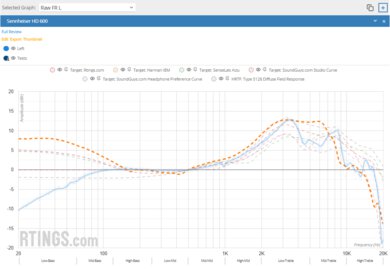
We've upgraded our Headphones Test Bench to 2.0! This update brings several key changes to our tests and usages, making it easier than ever to interpret our sound results based on your personal preferences. You'll also find a brand-new interactive graph tool featuring multiple targets (including our own!) for you to explore and compare.
For a full breakdown, check out our changelog, which includes detailed commentary from our test designer explaining the rationale behind our update.
We'd also love to hear your thoughts: your feedback helps us keep improving, so join us in the comments!
Test Results

These headphones have a fairly balanced sound out of the box that doesn't stray from our target curve much through their entire frequency response. There's a little extra bass, so kick drums and basslines feel thumpy and immersive, while voices and lead instruments are clear and accurate. If you want a different sound, you can customize these headphones using the parametric EQ and presets in their companion app.
The frequency response consistency is amazing. If you take the time to get the right fit, seal, and positioning on your head, you'll experience consistent audio delivery each time. We don't expect users to encounter as much deviation in the bass range as shown in the graph. We had trouble fitting the buds onto our testing rig's ears, even with the different silicone tips, but this isn't an issue that we'd expect you to encounter in real life.
The bass compliance is remarkable. The low and mid-bass are slightly boosted, so kick drums have just a little extra thump and punch, but the well-balanced high bass means that basslines never get overly boomy or muddy.
The mid-range compliance is superb. The range is pretty flat, so vocals and instrumentation in songs like Eleanor Rigby by The Beatles are clear and well-balanced in the mix. A slight bump adds a little extra presence to vocals in busy mixes, but it doesn't make them sound harsh or honky.
The headphones have outstanding compliance with our target curve in the treble range. The low- and mid-treble are generally flat, with a dip and a couple of small peaks that can make some higher-pitched instruments like cymbals sound unnaturally dull or present. In general, you won't notice these.
The JBL Vibe Beam have a good peaks and dips performance, indicating they don't deviate much from their balanced sound profile. The bass and mid-ranges are generally well-balanced, so instruments sound accurate. The treble range is more inconsistent. Sibilants can sound just a touch dull or piercing depending on their pitch.
These earbuds have adequate stereo matching between their left and right drivers. The upper-mids and treble perform well, but differences in amplitude between the left and right drivers can make low-frequency-based sounds like bass guitars or kick drums feel pulled to one side.
The group delay performance is good. You can expect clear and punchy bass from these cans.
By design, these headphones bypass your outer ear, so they don't interact with your pinna.
These headphones have amazing harmonic distortion performance. You can listen at dangerous levels and still hear clear, pure audio reproduction.
These are the settings we used to test these headphones. Our results are only valid with these settings.
The JBL Vibe Beam are simple in-ears with a similar look and feel to the JBL Live Pro 2 TWS True Wireless. They have an oval shape and a stem design that extends a little down your ear. You can find them in several different color variants, too.
They're fairly comfortable. The lightweight design sits easily in your ears without causing a lot of fatigue. However, the oval shape isn't ideal for all ear shapes, and even with the different-sized tips, it can be difficult to get a comfortable seal. Plus, they can fall out of your ears over time or move around in your ears when you use the controls. You'll want to take your time to get the right fit for a comfortable listening experience. If you're looking for in-ears with a more comfortable fit, try the Anker Soundcore P25i or the JBL Vibe Buds True Wireless.
The controls are pretty simple and easy to use. There's audible feedback as you adjust all the settings, too. In the JBL Headphones app, you can choose between one of three different presets to remap onto either the right or the left earbud:
- Tap once: Activates AmbientAware, which lets in some ambient noise around you to stay aware of your surroundings.
- Tap twice: Activates TalkThru, a feature that lets in additional ambient noise so you can have a conversation with people around you.
- Tap and hold: Activates Voice Assistant.
- Tap once: Increases the volume.
- Tap twice: Lowers the volume.
- Tap and hold: Activates Voice Assistant.
- Tap once: Plays and pauses audio.
- Tap twice: Skips to the next track.
- Tap three times: Skips to the previous track.
- Tap and hold: Activates Voice Assistant.
Ambient Sound Control:
Volume Control:
Playback Control:
Regardless of which of the three controls you set, when you get a phone call, you can double-tap to answer or hang up and tap and hold to reject a call or mute and unmute the microphone during the call.
That said, the issues with the buds' fit is relevant when adjusting the controls. Putting them into your ears can accidentally activate different commands. Tapping the controls can also move the buds in your ears, so you'll have to readjust them, which is annoying.
These buds are very portable. Their small and lightweight in-ear design is great for listening while out and about. They easily fit into your pockets, and you can even use the carrying case to protect them while on the go.
The case is good. Its small design is ideal for listening to music on the go since it can slide into your bag or your pockets. The middle lights also turn on to let you know its battery and charging status, which is a nice touch.
The JBL Vibe Beam have a good build quality. The buds and the charging case are made of matte plastic. These materials are on par with similarly-priced headphones, and while they don't feel the most premium, they're still pretty solid and sturdy. Plus, the buds are rated IP54 for dust and water resistance, and the case is rated IPX2, which is handy if you plan to use the headphones outside or at the gym.
The JBL Vibe Beam are fairly stable in your ears. When properly fitted using the included ear tips, they don't fall off during more casual listening sessions. That said, they slip out of your ears over time, which is annoying, and they aren't suitable for more intense runs, as they fall off when you shake your head intensely.
The JBL Vibe Beam True Wireless earbuds don't have an active noise cancelling (ANC) system. They do a passable job of blocking out some noises in the mid-to-treble ranges, though, like chatter from people sitting nearby or the hum of an AC unit. However, you still hear more bass-heavy background noise, like the rumble of passing traffic. You can also use their Ambient Aware feature to let in some background noise while you listen to audio or the TalkThru mode to let in a little more sound when you want to hold a conversation with someone.
These buds have a disappointing noise isolation performance in common scenarios. While their passive isolating fit does a passable job of blocking out street noise, like the rush of oncoming cars, they fare worse in environments like airplane cabins and noisy offices, where they struggle to block out bass-range noises in particular.
These headphones have a fantastic leakage performance. Since they don't leak much sound, you can listen to your favorite tunes without bothering those around you.
The integrated mic has a very good recording quality. The person on the other end of the line understands you, as your voice is clearly reproduced. However, your voice also lacks a bit of depth. If you want to control how much of your voice you hear while on the phone, you can always use the Voice Aware tool in the companion app.
The mic's noise handling performance is okay. It struggles to separate your voice from the ambient noise around you. Your voice is mostly clear, but background noise remains audible, which can be distracting. Louder noises, like a passing subway, can drown out your voice entirely.
The JBL Vibe Beam have a good battery performance. JBL advertises that they last for eight hours off a single charge, consistent with our findings. Their portable charging case offers two additional charges to help you power up on the go. They take little time to charge, too, which is handy for busy days out and about. Plus, the auto-off timer helps conserve energy by automatically shutting off the headphones when they aren't in use. You can turn this feature on in the companion app.
The JBL Headphones app gives you access to many tools and customization features. Here, you can turn on the Ambient Aware feature, which lets in some ambient noise while you listen to music to keep you aware of your surroundings, or Talk Thru, which lets in all the noise around you without removing your headphones. The Voice Aware feature is handy for taking calls, as it lets you control how much of your voice you hear while you talk. The parametric EQ and presets let you adjust their sound to your liking. Plus, you can map their controls, turn voice prompts on and off, and turn on the power-saving mode. A video of the app is available here.
You can't use these headphones over a wired connection. They only have a USB-A to USB-C charging cable for the carrying case.
These headphones have decent Bluetooth connectivity. Their app lets you choose between two modes: Audio Mode, for higher sound quality, and Video Mode, for lower audio latency. Our results represent their latency with Video Mode, which is somewhat high. However, Audio Mode has much higher latency, causing your audio and visuals to be very noticeably out of sync. Some devices compensate for latency differently, though.
You can connect the headphones to your PC over Bluetooth for full microphone and audio compatibility. They can't connect to PCs in any other way, though.

